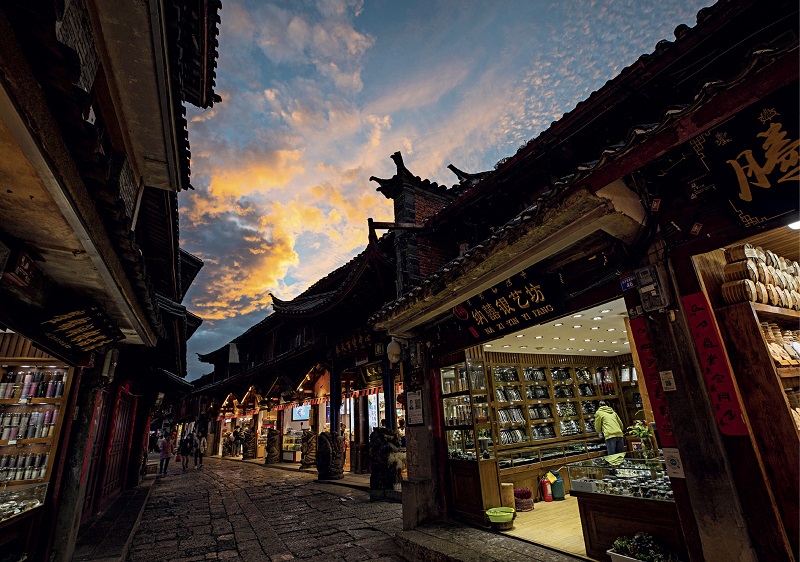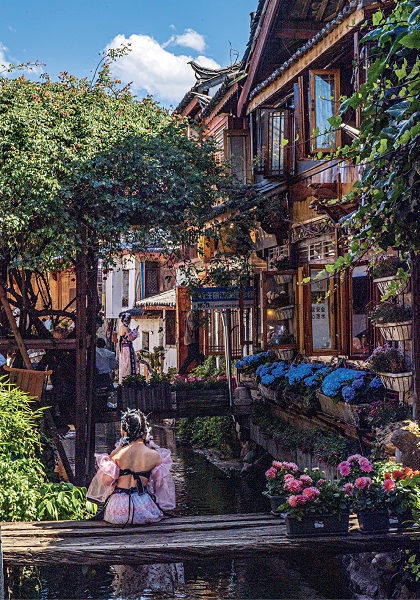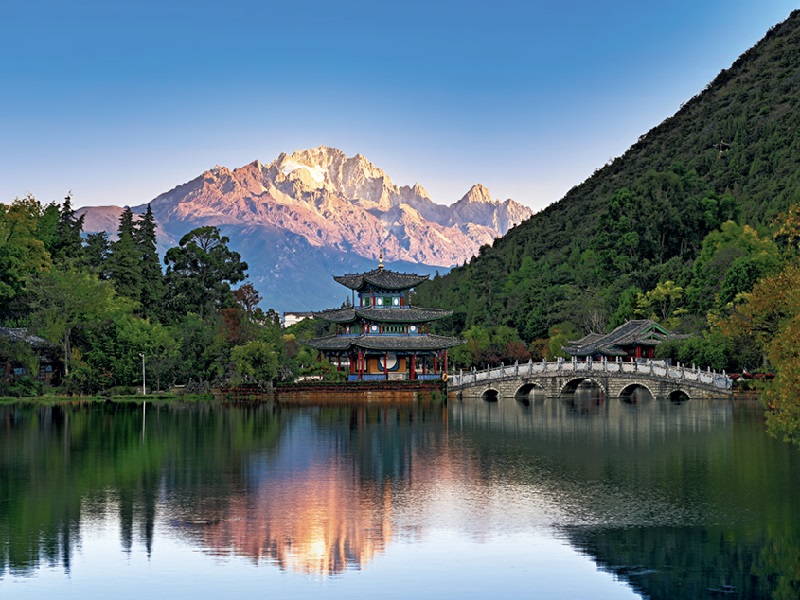The old town of Lijiang, also known as the town of Dayan, is located in Gucheng District in Lijiang City, southwest China’s Yunnan Province. The current structures of the town can be traced back to the end of the Song Dynasty (960-1279) and the early era of the Yuan Dynasty (1271-1368). It was once a political, economic, and cultural center in northwestern Yunnan. During the Han (206 BC-AD 220) and Tang (618-907) dynasties, the place was a key town on the southern Silk Road and the ancient Tea Horse Trail leading to present-day India and Nepal.
Covering an area of around 7.3 square km, the old town of Lijiang sits on the Yunnan–Guizhou Plateau at an elevation of 2,416 meters. Nestled in the embrace of the surrounding mountains, this ancient town thrived by utilizing its water network for centuries. It now boasts a number of attractions and historical sites, including the Mansion of the Mu Family, Sifang Street, and Wangu Tower. It has been rated a National 5A Tourist Attraction, and is one of the two ancient towns in China listed as a World Heritage site.

Shops lining the streets of the old town of Lijiang are lit up at sunset on November 28, 2020.
Unique Layout Shaped by Mountains and Rivers
This town was built on a plateau plain at the foot of Yulong Mountains. From anywhere in the town, residents can look up and see the imposing facades of the surrounding mountains. In addition to the Yulong Mountains, Xiangshan Mountains and Jinhong Mountains lie in the north, and Houzi Mountains in the west. The spring water coursing through the old town originates from the Heilong Pond at the foot of the Xiangshan Mountains. The water approaches the old town from the Yulong Bridge in its northwest and divides into three branches in the west, center, and east before flowing across the old town.
The layout, engineering techniques, and architecture of the old town of Lijiang represent the blending of the exceptional skills by the Han, Bai, Yi, and Tibetan people.
Streets in the old town are narrow and deep with many turns. Unlike most other cities in China, there are no city walls, but the three surrounding mountain ranges function as walls instead. Each household dwells beside a canal which is part of the larger water network composed of the three major river branches.
The gates and doors of buildings in the old town of Lijiang usually face south-east. This water-centered town exhibits a waterway-aligned spatial layout and is characterized by densely-arranged bridges. In terms of exterior shape and structure, the dwellings in the town signify the techniques and features of the Han, Tibetan, and Bai people. This can be seen in layered roofs, grey tiles, and wooden structures. These residential buildings were generally made of earth and wood. Some old dwellings are open to the public, allowing tourists to take a closer look.
The old town of Lijiang epitomizes the achievement of ancient Chinese cities, highlighting a unique style of Chinese dwellings.
Mansion of the Mu Family
The Mansion of the Mu Family was the residence of the Naxi people’s Mu clan who were in charge of Lijiang during the Yuan (1271-1368), Ming (1368-1644) and Qing (1644-1911) dynasties. Located at the east foot of the Shizi Mountains in the southwest of the town, the mansion was first built in the Yuan Dynasty, and renovated in 1998 after being designated as a museum.
This complex is composed of 163 rooms laid out along a 369-meter central axis. Sanqing Hall, Yuyin Tower, Guangbi Tower, Hufa Hall, Wanjuan Tower, Meeting Hall, and Loyalty Archway are situated in a line running from the west to the east. The 11 plaques awarded by emperors hanging in the residence are a testament to the prestige and history of the Mu family.
The Mu clan once ruled the Naxi ethnic group. The chieftain of the clan was appointed hereditary mayor of Lijiang by the emperor during the Yuan, Ming, and Qing dynasties. The family, having governed Lijiang for 470 years, were known for their efforts in cultivating education, good manners, and righteous character.
The gates of the mansion face east as Naxi people believe that greeting the rising sun would bring positive energy. The first erection in view after entering the complex is the Loyalty Archway which is an imposing three-story intricately-carved stone sculpture. The Meeting Hall is a magnificent room where political affairs were discussed. The Wanjuan Tower used to house a collection of cultural items, such as Dongba scriptures, Buddhist sutras, paintings, and the calligraphy of famous literati. The Hufa Hall was a place to discuss household affairs for the Mu family. The Guangbi Tower is the entrance to the garden. The Yulou Tower was the place to receive imperial edicts and host banquets, and the San-qing Hall is a sacred place for the Mu family to admire Taoist philosophy. In the deep forest of Shizi Mountains, there were religious sites for Naxi people to worship heaven, ancestors, and the god of nature.
Those buildings embody the inclusivity of the Naxi people. The Mansion of the Mu Family is a majestic architectural complex, epitomizing the elegant Han style of the Ming Dynasty, preserving some of the rustic and wild Han features of Tang and Song dynasties, and reflecting the Naxi traditions embodied in the east-faced layout.

Every house in the old town of Lijiang is located alongside a canal.
Wangu Tower
On the Shizi Mountains, there is a wooden sightseeing tower called Wangu Tower. This 33-meter five-story building employs the traditional Chinese dougong construction technique which forms a system of wooden brackets that can support the ceiling. The tower’s main body is supported by 16 wooden pillars with a height of 24 meters, each standing on the first floor and extending straight to the highest ceiling. In terms of its decorations, nearly 100,000 dragon patterns can be found in the form of paintings and sculptures.
The inscription on the plaque hung on the tower was written in Dongba pictograph, literally meaning “a tower for hundreds of years and thousands of generations.” As its name Wangu, which means looking down from the sky in Naxi language, suggests, the tower overlooks the old town of Lijiang. Standing atop it, tourists can also admire the towering Yulong Mountains afar and take in the mesmerizing vistas of both the natural and urban landscapes.
Sifang Street
The Sifang Street is the center of Lijiang. It is said that it was built in accordance with the shape of the government seal presented to the Mu chieftain by the Ming emperor. The street was once a vital transportation hub on the ancient Tea Horse Trail, hosting streams of businessmen from other places since the Ming and Qing dynasties. Over time, multiple ethnic cultures mixed and prospered here, making the street an economic and cultural center in Lijiang.
Today, Sifang is a food street lined with dozens of restaurants serving variations of Yunnan’s special dish — rice noodles. Therefore, the street is also known as Lijiang Rice Noodle Street.
In the west of the Sifang Street lies a three-story building called the Kegong Building. In 1723, the ruling Yongzheng Emperor of the Qing Dynasty ended the hereditary governance system by the Mu clan in Lijiang. In its place, the central government began to appoint officials selected through the imperial civil examination system to assume the leading governance position. During the reign of Emperor Jiaqing, Yang Zhaolan and Yang Zhaorong, the brothers of the Yang family who lived in Kegong Alley, passed the imperial civil examinations at the provincial level, making them eligible for positions as local officials. Later during the reign of Emperor Daoguang, Yang Zhaorong’s son Yang Shuochen passed the exam as well. To mark this great honor, the local government and community funded the construction of the Kegong Building in their honor.

A reflection of the imposing Yulong Mountain covered in a golden sheet of sunlight can be seen on the Heilong Pond on November 14, 2023.
Dashi Bridge
There are over 350 bridges in the old town of Lijiang. Those bridges come in a variety of types, mostly built between the 14th and the 19th century. Among them, the most noted is the Dashi Bridge, lying 100 meters east from the Sifang Street and built by the Mu family in the Ming Dynasty.
This stone bridge has two arches, with a total length of over 10 meters. Spanning a width of around four meters, it features a gentle slope enabling easy crossing between the banks. Because of the reflection of the Yulong Mountains, which are capped by snow, in the water under the bridge, this bridge is also named Yingxue Bridge, or “Snow Reflection” Bridge.
The stone bridges connect streets and alleys in the old town of Lijiang. Under the bridges, water has never stopped flowing, and the sound of footsteps and conversations on the bridges have never ceased for hundreds of years. The old bridges, spring water, diverse local residents, and snow-capped mountains capture and bring to life bustling, charming scenes from antiquity.